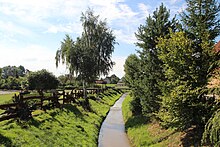Szklary (Kamiennik)
| Szklary Glass Village |
||
|---|---|---|

|
|
|
| Basic data | ||
| State : | Poland | |
| Voivodeship : | Opole | |
| Powiat : | Nyski | |
| Gmina : | Kamiennik | |
| Geographic location : | 50 ° 36 ' N , 17 ° 11' E | |
| Height : | 210-280 m npm | |
| Residents : | 550 (March 31, 2011) | |
| Postal code : | 48-388 | |
| Telephone code : | (+48) 77 | |
| License plate : | ONY | |
| Economy and Transport | ||
| Next international airport : | Wroclaw Airport | |
Szklary ( German Gläsendorf ) is a village in the rural community of Kamiennik in the powiat Nyski in the Opole Voivodeship in Poland.
geography
Geographical location
The street village of Szklary is located in the southwest of the historical region of Upper Silesia in the border area with Lower Silesia . The place is about four kilometers northeast of the municipality of Kamiennik , about 21 kilometers northwest of the district town Nysa and about 70 kilometers southwest of the voivodeship capital Opole . To the north and west of the village lies the border with the Lower Silesian Voivodeship .
Szklary lies in the Przedgórze Sudeckie (Sudeten foothills) within the Wzgórza Niemczańsko-Strzelińskie (Nimptsch-Strehlen-Heights) . The village lies on the Krynka (Kryhn) , a right tributary of the Oława (Ohle) . On the eastern edge of the village run the rails of the disused Otmuchów – Przeworno railway .
Neighboring places
Neighboring places of Szklary are Jaszów (Seiffersdorf) in the east, Cieszanowice (Tscheschdorf) in the south, the municipality seat Kamiennik (Kamnig) in the southwest and Wilemowice (Schützendorf) in the southwest .
history
The village was founded in the 13th century under German law as an elongated row village. In the work Liber fundationis episcopatus Vratislaviensis from the years 1295–1305, the place is first mentioned as Glezeri villa . For the year 1369, the place name Glesindorf has been handed down, as well as the first mention of a church in the place.
After the First Silesian War in 1742, Gläsendorf and most of Silesia fell to Prussia . A new stone church was built between 1752 and 1765. During a flood in August 1779, numerous houses in the village were destroyed.
After the reorganization of the province of Silesia , the rural community of Gläsendorf belonged to the district of Grottkau in the administrative district of Opole from 1816 . In 1833 a Catholic school was established in the village. In 1845 there was a Vorwerk, a Catholic parish church, a Scholtisei, a Catholic school, a brewery, a distillery, a coffee house, two taverns, a head forester's office and 193 other houses in the village. In the same year 193 people lived in Gläsendorf, 60 of them Protestants. In 1855 there were 1297 people in Gläsendorf. In 1865 there were 43 farmers, 44 gardeners, 37 cottagers, three water mills, a brewery with an inn and two inns. The Catholic school was attended by 1281 students in the same year. In 1874 the district of Gläsendorf was founded, which consisted of the rural communities Gläsendorf and the manor district Gläsendorf. The first head of office was the economic inspector König. In 1885 Gläsendorf had 1,119 inhabitants.
In 1933 there were 1018 people in Gläsendorf and 1024 people in 1939. Until the end of the war in 1945, the place belonged to the Grottkau district .
As a result of the Second World War, Gläsendorf fell under Polish administration in 1945, like most of Silesia . It was subsequently renamed Szklary and joined the Silesian Voivodeship. The German population was largely expelled . In 1950 it was incorporated into the Opole Voivodeship. In 1999 the place came to the re-established Powiat Nyski.
Attractions
- The Roman Catholic Church of St. Michael (Polish Kościół św. Michała Archanioła ) was built between 1752 and 1765. A church building was first mentioned on the same site in 1365. The church was built in the late baroque style. The interior is in the Rococo style. In 1945 the spire was destroyed and only poorly restored. The building has been a listed building since 1966.
- Boundary stone from the 14th century
- Watermill
- Stone wayside cross
- Stone wayside chapel
- Wooden wayside cross
societies
- OSP Szklary Volunteer Fire Brigade
- Football club LZS Szklary
Personalities
- Fritz Henkel (1885–1932) - German center party politician
Web links
credentials
- ↑ GUS 2011: Ludność w miejscowościach statystycznych według ekonomicznych grup wieku (Polish; XLSX ; 6.9 MB), March 31, 2011, accessed on March 18, 2020
- ↑ a b c d G. Wilczek: Greetings from the Grottkauer Lande. ed. from Bundesverband der Grottkau eV - home group district and city of Grottkau / Oberschlesien, 1996, p. 182.
- ^ H. Markgraf, Wilhelm Schulte: Liber fundationis episcopatus Vratislaviensis (= Codex Diplomaticus Silesiae . Volume XIV ). Breslau 1889 (Latin, dokumentyslaska.pl [accessed March 18, 2020]).
- ↑ a b Cf. Felix Triest: Topographisches Handbuch von Oberschlesien. Breslau 1865, p. 1224 ( preview in Google book search).
- ^ Johann Georg Knie : Alphabetical-statistical-topographical overview of the villages, spots, cities and other places of the royal family. Preuss. Province of Silesia. Breslau 1845, p. 159.
- ^ Territorial district of Gläsendorf
- ↑ Grottkau district. In: agoff.de, AGoFF , accessed on March 18, 2020.
- ^ Administrative history - Grottkau district ( Memento from September 3, 2017 in the Internet Archive )
- ^ Dehio Handbook of Art Monuments in Poland. Silesia. Deutscher Kunstverlag, Munich et al. 2005, ISBN 3-422-03109-X , pp. 904–905.
- ↑ Monument register of the Opole Voivodeship (Polish; PDF; 913 kB)



